Bridges: Ministering to Those Who Question
$20.95
Second edition, with a new chapter on ministering to and within mixed-faith marriages and families.
- “A deeply Christian book that calls upon us all to seek understanding and minister to the wounded.” — Terryl Givens
- “One of the most important books I have read in the past decade.” — Robert A. Rees
- “Honest, compassionate, and inspiring. . . . [Latter-day Saints] would be well-served to have a dog-eared copy of Bridges in every ward and stake council member's home.” — Patrick Q. Mason
- “Every Mormon leader (and teacher, and parent) should read this book.” — Jana Riess, Religion News Service
- “Bridges is a book that every Church leader and parent should read.” — The Millennial Star
- “I encourage you to read this book ... and then forward the book ... to members in your circle of influence and encourage them to do the same.” — Exponent II
- “A helpful and insightful resource for anyone wondering how to respond appropriately, kindly and compassionately to loved ones who are questioning their faith.” — Deseret News



Available in ebook for Kindle, Apple, Google Play, and Kobo.
And in audiobook through Audible, Amazon, and Apple.
Also available through Amazon, Deseret Book, and Benchmark Books.
Download a free sample preview.
Book Description:
With the advancement of the internet, changing worldviews, and the rising generation of millennials, Latter-day Saints today face unique challenges to faith on an unprecedented scale. Unlike most books written to help those struggling with their testimonies, Bridges: Ministering to Those Who Question is geared at helping local leaders and family members better understand the sources of these challenges and how to minister to those affected by them. This ministering is done through building bridges of love, empathy, and trust regardless of whether or not someone retains their belief or continues to participate. Author David B. Ostler, a former mission president, utilizes surveys with local leaders and disaffected members, research from social science and religious studies, and teachings from Church leaders to show how Latter-day Saints can work to better support those who have questions and create church environments where all can feel welcome.
AuthorCast Interview with the Author:
Comprehensive Table of Contents:
.
Introduction: Bridges
Section 1. A Crisis of Faith
1. A Different Time
People Leaving the Church in the United States Today
Not Just a Statistic: Personal Stories
Ministering to Those Experiencing a Crisis of Faith
2. How Societal Changes Affect Belief
The Millennial Generation
Technology
Switching Costs
Maintaining Faith in the Information Age
3. Why People Leave
Church History
Church LGBTQ Policies and Practices
Unequal Gender Roles
Feelings of Judgment and Anxiety at Church
Concern about Prophetic Leadership and Revelation
Cultural and Language Issues
Political Conservatism
Mental and Emotional Challenges
Unique Millennial Issues
Some Assumptions to Reconsider
4. Confronting Today’s Challenges of Faith
Study Church History
Focus on the Savior Jesus Christ
Remember That People—Including Church Leaders—Make Mistakes
Examine What Is in Your Truth Cart
Remember What You Do Know and Believe
Expect That Your Faith Will Change and Continue to Grow
Be Comfortable with Not Having All the Answers
5. How Faith Changes
My Faith Has Changed
Stages of Faith Development
Ministering to Those in Crisis
Section 2. Trust, Belonging, and Meaning
6. Trust
Losing Trust in Church Leaders
Building Trust as Church Members
Building Trust on an Organizational Level
Tailoring Trust to the Individual
7. Belonging
Understanding Belonging
Belonging at Church
Belonging at Home
Creating Places of Belonging
8. Meaning
Meaning That the Gospel Provides
Losing Meaning at Church
Finding Meaning at Church
Section 3. Ministering
9. Key Principles of Ministering
Listening
Avoiding Alienating Behaviors
Creating a Loving Relationship
10. Ministering at Church
An Invisible Problem
Making Church a Place of Ministering
Being Welcoming and Inclusive
Being Inclusive in Church Classes
Finding Faithful Ways to Address Concerns
Reconsidering the Concept of Worthiness
Disassociating Worth from Leadership Callings
Engaging Women and Listening to Their Perspectives
Using Our Councils
Ministering through Sacrament Meeting
Building Durable Faith in the First Place
11. Ministering in Our Families
Terminology
Chapter Background
The Importance of Families
It Begins in Unity
A High-Demand Religion
Interviews
Characteristics of Strong Marriages
Other Practical Tips
Tips for Family, Friends, and Leaders
Parents Feel Pain, Too
Ways to Minister
Common Conflicts for Parents
To Those Who Leave
Create a Journey of Love
Conclusion: Not Walking Alone
Appendix: Recommended Resources
Academic Resources on Religious Retention and Disaffiliation
Faithful Resources Addressing Faith Given Today’s Challenges
Faithful Resources Addressing Church History and Contemporary Issues
Faithful Websites and Podcasts Addressing Contemporary Issues
Q&A with the Author:
.
Q: Give us a brief background into who you are and why you decided to write this book.
A: I’m a retired father and husband, with six children and five, almost six, grandchildren. My children are wonderful and some no longer believe in basic principles and doctrines of the Church. I’ve been a leader in the Church and with my wife, served two full time and two church service missions. Our last mission was in our stake, working with leaders to better understand why people disaffiliate from the Church.
As we worked with our stake leaders, we research and studied the frequency and causes why people, particularly previously faithful adults, choose to disaffiliate. We found that Church-wide most leaders see disaffiliation as a very important concern in their ward, stake and particularly in their family. We also found that many leaders were not fully aware of the underlying reasons and didn’t feel they fully understood how to help. They probably feel the same in their homes.
So, after completing that calling, I decided that I could take what we learned and create a resource for members to better understand why people leave so that we could find common ground, build understanding and truly minister to those who no longer worship with us. I conducted some original research, interviewed leaders and disaffiliated members, and studied the words of our Church leaders as well as experts in the field. In this research, I learned that the pain of disaffiliation isn’t just felt by that person’s family or leaders, but also by the disaffiliating member. They often feel isolation, fear, anger and other hurtful emotions; often unintentionally caused by their family, friends, and leaders.
I hope this book can bridge that misunderstanding and give us a better understanding to build trusting and meaningful relationships with those who no longer believe as we do.
Q: Who is your intended audience for the book and how do you hope it will be used?
A: I think there will be two readers for the book. I wrote the book for fully believing members so that they can better understand their friends, ward member, or family member who no longer believes in the truth claims of the Church of Jesus Christ of Latter-day Saints. I hope it gives each reader understanding on how to build a trusted relationship with that person. With that understanding, I hope that some of the pain, fear, and hurt that is felt on both sides can be turned into love and acceptance. Perhaps in some cases, that understanding will create an opportunity for someone to “come back” or to have someone “stay.” For believing members, I hope that reading this book will help build a bridge with a better understanding as they minister to those who doubt.
I also realize readers will include some who no longer believe. I hope that this book will give them hope that we are trying to be more understanding and that their relationship with their families, friends and Church members can be strong and rich, even with differences in belief.
This isn’t a leadership book. But knowing that each leader is also a member and that we rotate in and out of ward and stake callings, I include some ideas that leaders can use with their callings. The principles are the same and can be applied in families, with friends, as church members, and when we serve in church callings.
Q: We hear numerous reports of religious disaffiliation in our modern age, particularly in Western society. How are these trends reflected in The Church of Jesus Christ of Latter-day Saints?
A: All churches and denominations are experiencing a drop in membership and participation. Younger Americans, particularly Millennials and Gen-Z, see little need to participate in organized religion. In fact, the fastest-growing group of religious identification is “spiritual, but non-religious.” As Latter-day Saints, we are experiencing these same trends. The underlying reasons include society’s broad acceptance of those who are non-religious, people being comfortable going it alone, less trust of institutions in general and of religions specifically, more opportunities to find friends and like-minded people through social media and other settings, and more. The reasons are many.
For the Church in the United States, data from social scientists show that disaffiliation for those born after 1970 is about 39% and, although the sample size is low, that 55% of millennials have disaffiliated. Most of those who disaffiliate remain on the rolls of the Church, but no longer think of themselves of Latter-day Saints. And they disaffiliate younger than previous generations. The average age of millennial disaffiliation is 18.4 years while for boomers it was 23.7 years.
Q: What are a few root causes for religious disaffiliation among Latter-day Saints?
A: Latter-day Saints experience all the same issues as other religions, but there are unique issues which we face. Some leave because they become aware of issues in our history which are controversial or seem inconsistent with our values. They may have concerns about particular Church policies, like our teachings about LGBTQ issues. They may disagree with the way in which women and men serve and experience the Church. Church culture and what they experience in their wards and classes may feel judgmental and perfectionistic. They may be different in some way, like being childless, or being single, experiencing mental illness, being politically liberal. Others just don’t feel the Church addresses the areas which are meaningful to them, including issues of social justice, poverty, racism, sexism or violence.
Q: What are a few typical responses among families and congregations towards those who disaffiliate or become disaffected with the Church’s teachings?
A: As I interviewed members and read their comments and experiences in my surveys, I was frankly surprised by the disconnect between fully believing members and local leaders and those who doubt, question, or have left the Church. Many believing members feel the primary reasons why people leave is because they are offended, have sinned, or are lazy. They sometimes blame the disaffiliating member for having not studied scriptures, prayed, or attended the temple often enough. Those members who are struggling with their faith often have serious doctrinal, historical, or cultural concerns about the Church. When members or local leaders don’t have a true understanding of why these people leave or struggle to stay, their efforts are often ineffective, or worse, hurtful, and push members further away.
Sometimes it is because they don’t understand, but also, it causes fear when a family member learns their child, sibling, or spouse is struggling with belief. It threatens their hope for an eternal family as they worry about their spiritual welfare.
Without thinking about it, we make a snap judgment as to why they have left and assume that it is because they have been offended or because of secret sin. We may be afraid to ask them because we don’t want to offend them. We might keep them at arm’s length and be afraid that they will infect us with doubt. Some disaffiliated members feel that they are labeled as “anti-Mormon” or “apostates” and don’t feel that they are welcome. We may exclude them from our social life because we are uncomfortable with them or with having our children associate with them. Leaders may release them from their callings even though they are willing to serve.
Sometimes in our interactions with disaffiliated members, we seek to testify or explain away their concerns when they just want to keep their close relationship, friendship, or continue to worship even with their doubts.
Q: What are a few ways we can minister to disaffiliated and disaffected members, both individually and as congregations?
First and most important, we need to learn to listen to them individually and collectively. We really don’t know their concerns unless we take the time to listen. Listening is hard—it means that we suspend trying to explain their decision and instead really let them share with us what they are feeling and why. Our minds will naturally try and explain it away and find the fault in their logic or life that lead them to their new beliefs. As they are talking, our minds might be filled with how we can counter their concerns. We might be tempted to encourage them to read more scripture, pray harder, or go to the temple. But first, we need to just listen to understand their concern and why it is important to them. Giving unsolicited advice rarely works.
While listening, we need to take their concerns seriously. These issues are very real to them and we should never try and minimize their concerns. We need to validate, even if we disagree. Later, after they know that we really care about their concerns and how it impacts them, perhaps we can discuss ways to think about the issue or even more forward without a clear resolution.
Q: What brief message can you offer to family members or friends of individuals who have become disaffected with the Church’s teachings or who have chosen to disaffiliate?
A: As we listen and validate, we can answer some questions; and when we can’t, we can mourn and comfort our family or friend who has become disaffected. We can find common ground, even if we aren’t 100% united in the values we live and in our spiritual beliefs. Our relationships can be meaningful, close, and full of love, even with these differences.
If they come back, that’s wonderful. If they don’t, we can trust the Lord and enjoy every moment, even within our differences. I take great comfort from Elder Orson F. Whitney, who said, “Our Heavenly Father is far more merciful, infinitely more charitable than even the best of his servants, and the everlasting gospel is mightier in power to save than our narrow finite minds can comprehend.” Our Heavenly Parents love our family members or friend far more than we can comprehend. They want their happiness too, today and forever.
David B. Ostler
July 2019
Praise for Bridges:
“Even in a culture of the religiously disaffected, the toll on Latter-day Saint faithful is alarming. David Ostler’s book does not aim to stem the tide, but to lessen the pain of those on both sides of the faith divide. It is a deeply Christian book that calls upon us all to seek understanding and minister to the wounded.” — Terryl Givens, co-author of The Crucible of Doubt: Reflections on the Quest for Faith
“David Ostler’s Bridges: Ministering to Those Who Question is one of the most important books I have read in the past decade. Unlike other good books written primarily to those experiencing a crisis of faith, Bridges is written to those who have been called as leaders, fellow saints, and family members to minister to those who once were included in our circle of fellowship and love but who no longer are. It should be required reading for every general and local authority of the Church and every Latter-day Saint parent or other adult who interfaces with those experiencing what is called the ‘Mormon faith crisis.’” — Robert A. Rees, Co-founder and Vice-President, Bountiful Children's Foundation
“Leaders, parents, and friends often feel at a loss when someone they love experiences a faith crisis and leaves the church. How did this happen? What can I do? How can I help? Their sincere love and concern is now perfectly matched by the information and advice in this honest, compassionate, and inspiring book by David Ostler. The church—meaning both the people and the institution—would be well-served to have a dog-eared copy of Bridges in every ward and stake council member's home.” — Patrick Q. Mason, author of Planted: Belief and Belonging in an Age of Doubt
“All denominations struggle to keep younger generations engaged, but the Latter-day Saint tradition is particularly challenged by the ‘faith crisis’ that occurs when Church members are suddenly confronted with inconvenient truths about its history and doctrine. While other authors have described the phenomenon generally, David Ostler gives us unprecedented access to one of its core elements: the disconnect between what members in crisis are experiencing and how Church leaders are responding. Using data from his own surveys, he not only identifies the dimensions of the disconnect but also gives sensible and helpful suggestions for bridging it. Brutally candid at times, it is nonetheless lovingly written in an attempt to stem the outflow of Church members.” — Gregory A. Prince, author of David O. McKay and the Rise of Modern Mormonism and Gay Rights and the Mormon Church: Intended Actions, Unintended Consequences
“Every Mormon leader (and teacher, and parent) should read this book.” — Jana Riess, Religion News Service
“The most important book on Latter-day Saint faith crises yet.” — Wheat and Tares
“A good step in the direction of teaching the rank and file how to avoid judgmental behavior and seek to be understanding of those outside our often culturally constructed norms and those who struggle with dissonance over history or doctrine or practice. I recommend it for every bishop’s bookshelf.” — By Common Consent
“Bridges is a book that every Church leader and parent should read. While the solutions offered do not guarantee our family and friends will remain with the Church, it will guarantee that there is an open bridge for them available, if they ever choose to cross back over.” — The Millennial Star
“If our intention is to create positive change in our wards and stakes I encourage you to read this book ... and then forward the book ... to members in your circle of influence and encourage them to do the same.” — Exponent II
“Bridges was written for people like me, involved with local level ministry, who want to reach out to our congregation in ways that don’t condescend or colonize, but would really like to support and help them according to their own will.” — Dan Call, Association for Mormon Letters
“Bridges is a helpful and insightful resource for anyone wondering how to respond appropriately, kindly and compassionately to loved ones who are questioning their faith. It’s also a useful tool for leaders who may find it challenging to know how to help those who question and doubt church doctrine and teachings.” — Deseret News
“This book is not just a list of the problems and solutions, it is a fully contextualized examination of what sincere ministering looks like. His book is practical and readable. It is accessible and timely. Anyone who reads Bridges in good faith will discover tools and have impressions that can help them become better citizen of any community. If members of the Church of Jesus Christ of Latter-day Saints read this book, it will make them more effective leaders and more inspired and inspiring advocates of the Church’s highest ideals. The book has the power to transform the Church culture into a healthier, stronger, and more caring culture.” — Douglas Christensen, Association for Mormon Letters
About the Author:
 David B. Ostler has experience serving Latter-day Saint members and leaders as a bishop, stake president, and mission president. He has a BUS from the University of Utah and an MBA from Dartmouth College and is now retired from a thirty-year career as a business executive managing domestic and international businesses focused on improving health care. With his wife, they have six wonderful children—some of whom no longer hold basic Latter-day Saint beliefs.
David B. Ostler has experience serving Latter-day Saint members and leaders as a bishop, stake president, and mission president. He has a BUS from the University of Utah and an MBA from Dartmouth College and is now retired from a thirty-year career as a business executive managing domestic and international businesses focused on improving health care. With his wife, they have six wonderful children—some of whom no longer hold basic Latter-day Saint beliefs.
More Information:
2nd ed.:
228 pages
ISBN: 978-1-58958-759-5 (paperback)
1st ed.:
197 pages
ISBN: 978-1-58958-726-7 (paperback); 978-1-58958-719-9 (hardcover)
Published August 2019
Press sheet

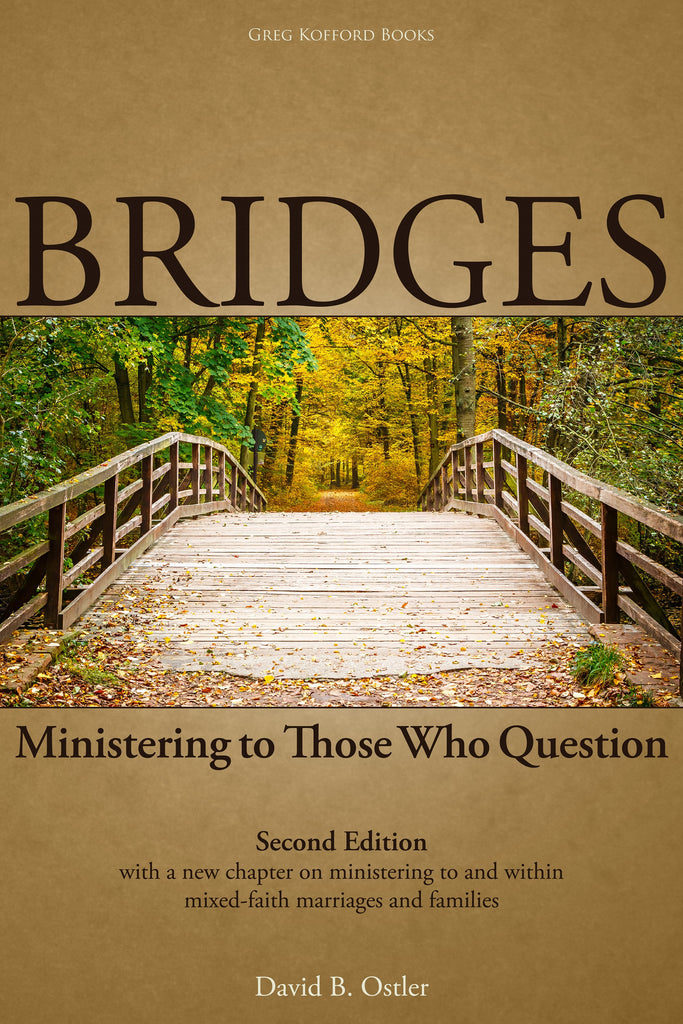




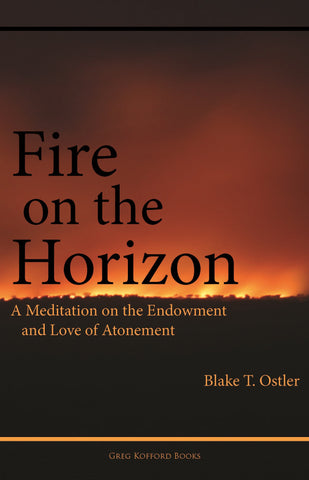
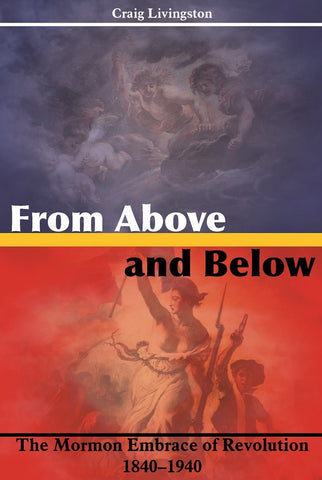
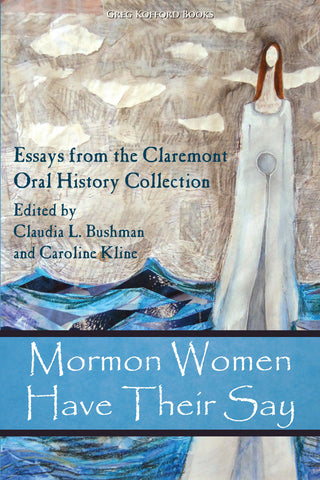
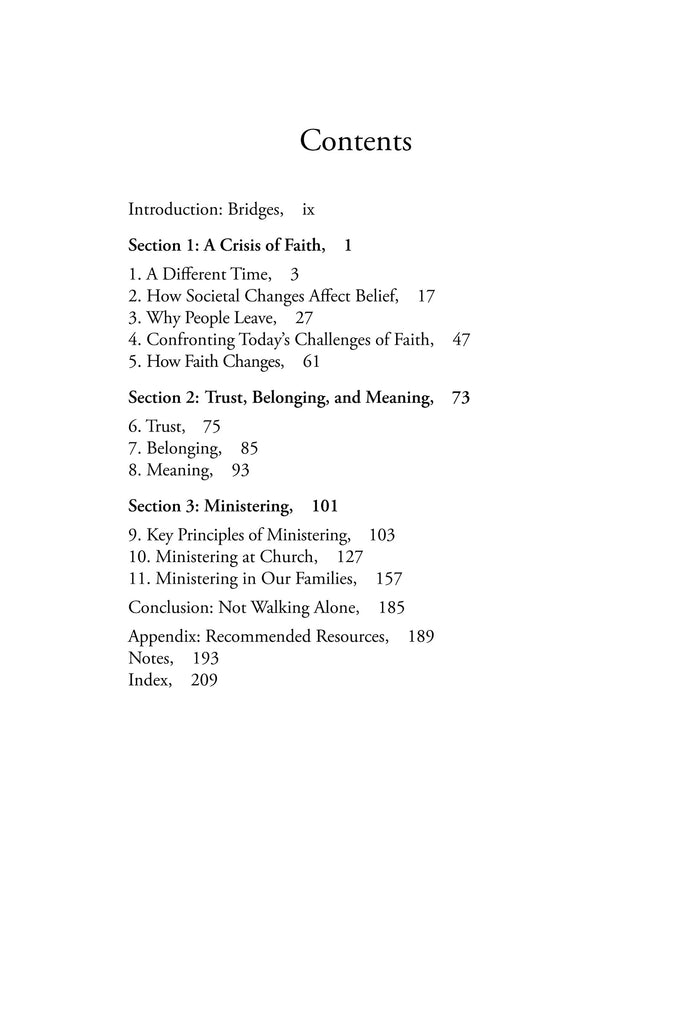

Share this item: